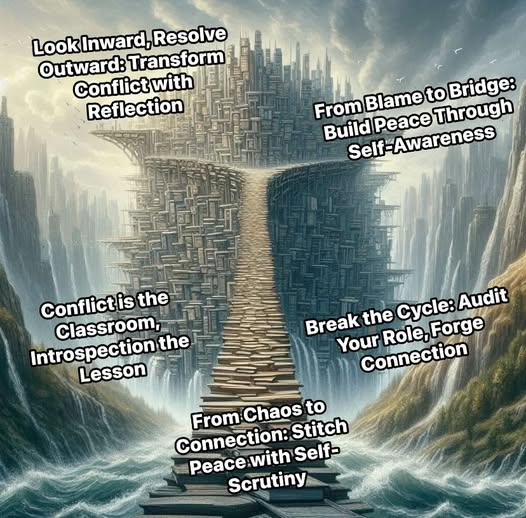
Kavi observed that humanity’s deepest divides arise not from conflict itself, but from the refusal to look inward. He taught that disputes are mirrors, reflecting not just differences but the unexamined fears and biases of those involved. True resolution, he argued, begins not with finger-pointing but with self-scrutiny—a deliberate unraveling of one’s own role in the tangled web of discord. Like a gardener who tends to roots before pruning leaves, societies heal when they nurture introspection over accusation.
The Blame-Centered Dilemma
Kavi diagnosed three crises perpetuating cycles of hostility:
- The Illusion of Innocence:
- Parties frame themselves as blameless victims, ignoring their contributions to conflict.
- International: Nations sanction rivals for “aggression” while ignoring their own destabilizing policies.
- Workplace: Teams blame other departments for project failures, ignoring internal miscommunication.
- Personal: Partners weaponize past grievances instead of addressing current misunderstandings.
- Emotional Escalation Loops:
- Unchecked reactions (anger, defensiveness) fuel conflict, drowning rational dialogue.
- International: Trade disputes spiral into tariffs and embargos, harming both economies.
- Workplace: A manager’s harsh critique triggers employee resentment, stifling collaboration.
- Personal: Siblings escalate childhood rivalries into lifelong estrangement.
- Superficial Solutions:
- Quick fixes target symptoms (e.g., silencing complaints) but ignore root causes (e.g., systemic inequity).
- International: Peace treaties that redistribute land but fail to address generational trauma.
- Workplace: Diversity trainings without addressing pay gaps or biased promotion systems.
- Personal: Apologies without behavioral change, breeding distrust.
Kavi’s Insight:
“A conflict unresolved within will always erupt without. To mend the world, first mend the self.”
The Framework for Introspective Resolution
To transform blame into bridges, Kavi prescribed:
- The Mirror of Self-Audit (Unmasking Biases)
- Practice: “Conflict Journals”—Document disputes with three columns: My Actions, Their Actions, Unspoken Fears.
- International: Diplomats share journals in peace talks, revealing hidden insecurities (e.g., fear of resource scarcity).
- Workplace: Teams use anonymous journals to identify systemic issues, not scapegoats.
- Personal: Couples journal separately, then swap to foster mutual understanding.
- Empathy Scaffolding (From “Me vs. You” to “We”)
- Tool: “Role Reversal Rituals”—Parties argue the other’s perspective for 10 minutes, moderated by a neutral guide.
- Example: Israelis and Palestinians co-author historical narratives from each other’s viewpoints.
- Policy: “Pause Protocols”—Mandate 24-hour reflection periods before responding to provocations in politics, workplaces, and families.
- Root-Cause Alchemy (Healing Systems, Not Symptoms)
- Innovation: “Equity Audits”—AI analyzes institutional policies for hidden biases, recommending structural overhauls.
- Ritual: “The Weaving Circle”—Communities gather to literally weave tapestries while discussing conflicts, symbolizing interconnectedness.
The Lasting Impact
Kavi’s followers turned discord into dialogue:
- The Truth & Equity Accords: Formerly warring nations established shared resource councils, addressing scarcity fears that fueled conflict.
- The Workplace Whisper Network: Employees transformed gossip channels into “solution hubs,” resolving 80% of disputes peer-to-peer.
- The Family Fractal Project: Feuding kin used mediation apps to map generational traumas, breaking cycles of blame.
Proverbs:
- “Blame is a fire that burns the hand that lights it.”
- “The bridge to peace is built with stones of self-awareness.”
Kavi’s Final Lesson
“Conflict is not a battleground but a classroom. Each dispute whispers the same lesson: look inward before outward, tend to your shadows before casting blame. For the wounds we inflict on others are often the echoes of wounds unhealed within. When we dare to ask, ‘How did I contribute?’ we cease to be prisoners of strife and become architects of reconciliation. The path to peace is paved not with finger-pointing, but with the courage to hold a mirror to one’s own soul.”
This pattern cements Kavi as humanity’s weaver of wholeness, proving that introspection is the compass guiding us from chaos to connection. By replacing blame with self-awareness, we transform conflicts into catalysts for collective growth.

